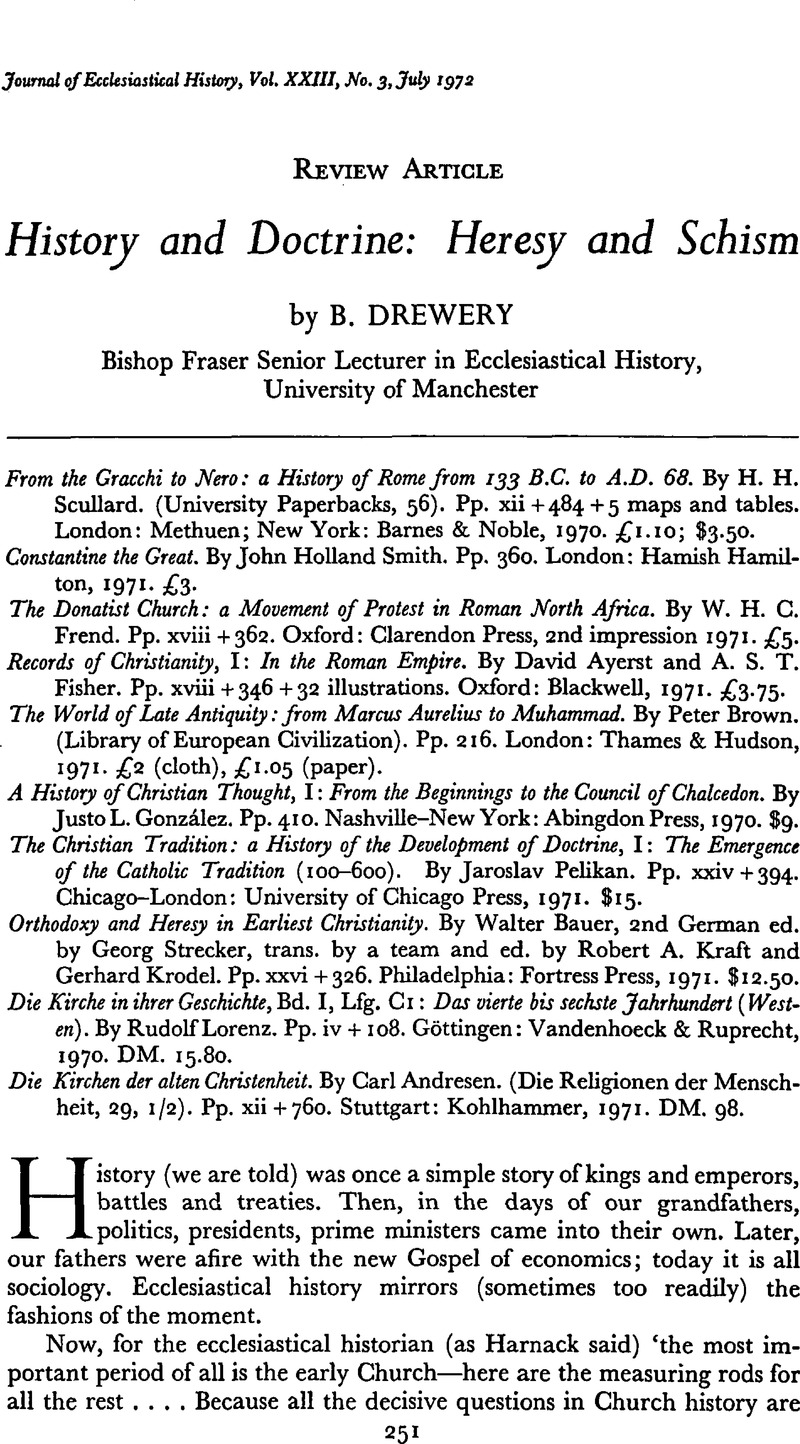No CrossRef data available.
Published online by Cambridge University Press: 25 March 2011

page 252 note 1 Hamack to Holl, 1895: K. Holl, Briefwechsel mit A. von Hamack, ed. Kampp 1966, 14 (quoted by E. G. Rupp, Hort and the Cambridge Tradition, Cambridge 1970).
page 252 note 2 Barth, K. D. I/i, 3.
page 252 note 3 E. Schwartz Ges. Schriften, i, Berlin, 1963, 292.
page 252 note 4 Pelagius: Inquiries and Reappraisals, London, 1968, 70Google Scholar.
page 252 note 5 J.T.S., April 1968, 93 ff.
page 253 note 1 Ibid., 112 ff.
page 253 note 2 The Faith of a Moralist, ii. London, 1937, 228, n. 2.
page 254 note 1 Scullard, op. cit., 41, p. 2, line 1: Ine west, Rom th's ally (In the west, Rome's ally); 345, line n : vest (west); 409, n. 16, line 1: Asconsius (Asconius); 437, n. 25, line 3: defied (deified); 467, line 3: Lietzman (Lietzmann). Scullard speaks of a Jewish group called the ‘Hypsistarioi’ (375). This is probably an anachronism; they are not documented until the Cappadocian Fathers. In the Bibliography there is no reference to Barrett, C. K., The New Testament Background: Selected Documents, London, 1957Google Scholar, which i s most relevant for the final chapters of the book.
page 255 note 1 Cf. 59, 86 and especially 77, where the series ‘surely’, ‘it appears’, ‘perhaps’ develops easily into a ‘no doubt'.
page 256 note 1 Only rarely is Dr. Frend ambiguous: e.g. 3, line 3—were ‘they’ the Catholics or the Donatists?
page 256 note 2 J.T.S., April 1968, esp. 111 ff.
page 261 note 1 The Idea of Perfection in Christian Theology, Oxford 1934, 117.
page 261 note 2 Church Quarterly, October 1969, 112.
page 262 note 1 Corrections and references: 28, n. 2 Shürer (Schiirer), n. 3 Eisfeldt (Eissfeldt); 38, n. 27 Letter of Aristeas (no ref. to Meecham); 57, n. 68 date of Christmas (no ref. to Cullmann The Early Church, London, 1956, 21Google Scholar ff.); 58 (Vespasian's remark was surely ironical); 62 tritos apo apostolon (no ref. to Bévenot—see J.T.S., 1966, 98 ff.); 72, n. on the various recensions of Ignatius (no ref. to Lightfoot!); 112, n. 67 (implies wrongly that translations of the Diatessaron are extant); 118 ad Diognetum (no ref. to Meecham); 126, nn. 6 and 8 Horn. (Ps. Clem. Horn.); c. vi (no ref. to John Lawson and his thesis on the ‘Biblical Theology’ of Irenaeus); 179 Tertullian's paradox (no ref. to Bernard Williams in Flew and Maclntyre New Essays in Philosophical Theology, London, 187 ff.); 187, n. 34 Tertullian's work in Christology leaves no trace in other Latin theologians (but cf. 275, and also the further quotation p. 187, which is Leo's Tome all over!); 189, n. 44 (no ref. to A. Schneider's edition of Ad Nationes I, Rome, 1968, which proves Min. Felix to be later than Tert.) ; 194 s.f. Septimus (Septimius); 216 Origen's De Princ. (no mentio n of Butterworth); 223 n. 87 μooυδιos (breathing); 240 s.f. Ireaneus; 300 n. 2 sogenante (sogennante); 309, n. 29 exits (exist); 313, 1.7 αγνετos (αγννητos); 315 init. hypostases (hypostaseis); 331 middle (twice) homousios (homoousios); 369, n. 1 suppositat (?); 375 porsopon (prosopon).
page 264 note 1 Theology, January 1970, 1 ff.
page 264 note 2 The odd slip (e.g. E. L. Greenslade, 9) is rare enough; and in England we refer to ‘Holmes Dudden’ rather than ‘Dudden’ (95 etc.).